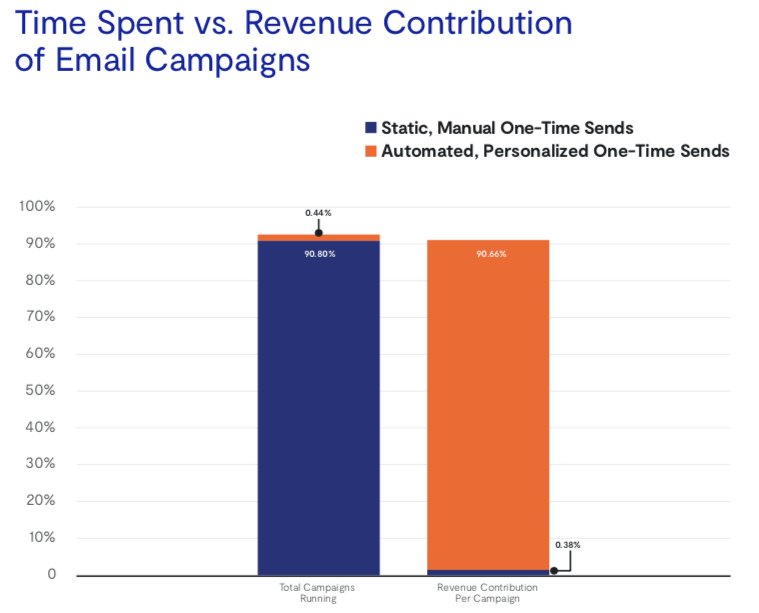
Segmentation is Not a Proxy for Personalization
The ecommerce marketing emails that perform best across all measures (think all the traditional metrics: opens, engagement, CTR, conversions) have one thing in common: They are extremely relevant to their recipients, meaning the products, offers and content of the email actually matter to each shopper.
Retailers can achieve relevance through personalization or coincidence (e.g. a seasonal email that happens to show a product or offer that is meaningful to someone).
Traditionally, brands have used audience segments to try to achieve relevance without having to make hard decisions around products, offers, content, priority and timing. However, this approach is suboptimal as it leaves money on the table for brands and ends with most consumers feeling frustrated after receiving content and offers about which they don’t care.
Instead, the retailers that see the biggest returns focus on relevance by going beyond simple segmentation to deliver true personalization.
Segmentation vs. Personalization: The Difference Matters
Is there a difference between segmentation and personalization? And does it even matter? Yes and yes.
Segmentation involves dividing your customers into audiences based on broad factors like location or product interest. It usually requires a CRM or CRM-type system, normalized data and attributes tied to a targetable ID, as well as some broad-based understanding of different buyer types that coordinate to different product or offer affinities.
Personalization involves creating unique experiences for individual customers based on factors like product, content or offer recommendations and priority and timing of your communications. Personalization is a tactic to achieve relevance and to achieve a specified business outcome.
Segmentation can be (a manual) way to develop a personalization strategy, but segmentation does not equal personalization.
For example, if you build an audience of people who have bought shirts in the past and send them a static email featuring shirts at a single point in time, that is segmentation. But if you (1) build an audience of people who have bought shirts in the past, (2) send them an email with personalized product recommendations that populate based on their individual browsing patterns and (3) apply send-time optimization so the email sends at the best time for each recipient, that is personalization.
While both examples have the same audience, the second example provides each recipient with unique recommendations based on their past behavior and predicted interests and it ensures they receive the email at a time when they are most likely to engage. As a result, two people in this audience can receive different emails at different times, creating truly personalized experiences.
The Power of Personalization in Email Marketing
Time and again benchmark data underscores the power of personalization in email marketing.
Consider the case of one athletic retailer that recently ran a test pitting non-personalized emails against emails featuring personalized 1:1 product recommendations. In this head-to-head test, the personalized emails delivered performance gains at every level compared to the segmented emails, including a 57% increase in revenue per email.

These increases in performance stem from the fact that shoppers are more likely to engage with emails when the products featured are relevant to their interests. Over time, this level of personalization can help brands stand out in crowded inboxes and encourage continued engagement since shoppers will come to expect consistently relevant email content.
While audience segmentation is certainly a good step toward achieving this goal, it’s only a first step. And it typically creates more work, as it requires cutting and managing lists, building out offer and product strategies with merchandising and taking on highly cumbersome optimization tactics. Using the example above, simply segmenting your audience to find a group of shoppers interested in shirts helps narrow down which products to promote, but shirts is still a broad category and then requires more work with analytics or guesswork. Even segmenting shirts by gender only narrows it down slightly, and it leaves out cross-category shoppers like a mom shopping for her son.
To ensure relevance for every recipient and see significant increases in engagement as a result, you need to get truly personalized at every level. This personalization can include any or all of the following:
- Dynamic product recommendations that populate for each individual based on factors like co-purchase patterns, next best purchase recommendations or predicted affinities
- Dynamic content and offers that populate for each individual based on factors like discount preference, customer lifecycle stage and purchase history
- Dynamic send times to optimize for engagement with each individual
Moving Beyond Segmentation to Personalization
Understanding the power of personalization in email marketing is one thing. Being able to move beyond segmentation to deliver that personalization is quite another.
Historically, brands have had difficulty scaling personalization. These challenges typically result from using decades-old email marketing technology that was built to solve decades-old problems (like simply achieving reach via send volume and a basic understanding of your audience). Given how these technologies were built, they make moving beyond segmentation difficult.
However, a new generation of retail personalization software has arrived, giving us modern ESPs built to solve modern problems (like personalization). These modern ESPs support the move from segmentation to personalization by providing marketers with easy access to customer, behavior and product data and allowing marketers to activate that data in a timely manner.
One of the best examples of how a modern ESP can support the shift from segmentation to personalization is the introduction of a new type of email, known as a Smart Promo campaign. The Smart Promo campaign allows marketers to automate the build and delivery of personalized one-time sends. It combines the basic idea of a one-time send (a broadcast announcement not based on any specific customer behaviors or changes to products) with the functionality of a triggered email (an automated email that gets set up once, runs on its own and features dynamic recommendations).
An IR 100 apparel retailer recently launched one Smart Promo campaign alongside its static, manually created one-time sends and saw the full power of personalization in action. Although the Smart Promo campaign only made up less than 0.5% of live email campaigns for the retailer, it contributed to just over 90% of campaign revenue.

These numbers don’t just indicate the power of personalization, they also highlight the ease of ecommerce personalization with a Smart Promo campaign — the latter of which has traditionally been the biggest barrier marketers face in executing personalization initiatives.
Benchmarking Your Personalized Email Marketing Program
Once you begin personalizing more of your email marketing program, how do you measure success? Download Bluecore’s 2019 Retail Email Benchmark Report to get the nuanced email benchmarks you need to measure even the most personalized email campaigns.




